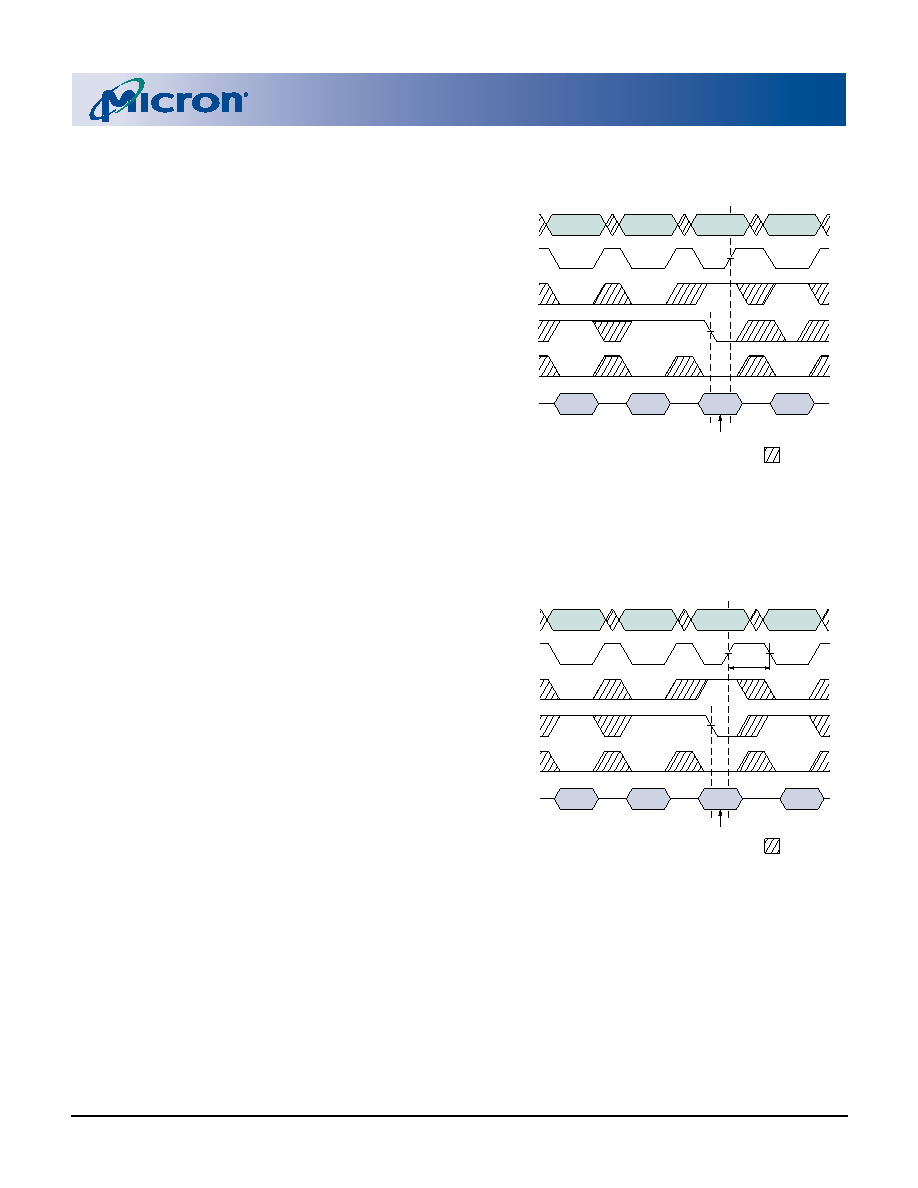- 您現(xiàn)在的位置:買賣IC網(wǎng) > PDF目錄299522 > MT45W2MW16BBB-856WT 2M X 16 PSEUDO STATIC RAM, 85 ns, PBGA54 PDF資料下載
參數(shù)資料
| 型號: | MT45W2MW16BBB-856WT |
| 元件分類: | SRAM |
| 英文描述: | 2M X 16 PSEUDO STATIC RAM, 85 ns, PBGA54 |
| 封裝: | 6 X 8 MM, 1 MM HEIGHT, 0.75 MM PITCH, LEAD FREE, VFBGA-54 |
| 文件頁數(shù): | 9/56頁 |
| 文件大小: | 709K |
| 代理商: | MT45W2MW16BBB-856WT |
第1頁第2頁第3頁第4頁第5頁第6頁第7頁第8頁當(dāng)前第9頁第10頁第11頁第12頁第13頁第14頁第15頁第16頁第17頁第18頁第19頁第20頁第21頁第22頁第23頁第24頁第25頁第26頁第27頁第28頁第29頁第30頁第31頁第32頁第33頁第34頁第35頁第36頁第37頁第38頁第39頁第40頁第41頁第42頁第43頁第44頁第45頁第46頁第47頁第48頁第49頁第50頁第51頁第52頁第53頁第54頁第55頁第56頁

4 MEG x 16, 2 MEG x 16
ASYNC/PAGE/BURST CellularRAM MEMORY
09005aef80be1fbd pdf/09005aef80be2036 zip
Micron Technology, Inc., reserves the right to change products or specifications without notice.
Burst CellularRAM_2.fm - Rev. D 9/04 EN
17
2003 Micron Technology, Inc. All rights reserved.
Software Access
Software access of the configuration registers uses a
sequence of asynchronous READ and asynchronous
WRITE operations. The contents of the configuration
registers can be read or modified using the software
sequence.
The configuration registers are loaded using a four-
step sequence consisting of two asynchronous READ
operations followed by two asynchronous WRITE
operations (see Figure 14). The read sequence is virtu-
ally identical except that an asynchronous READ is
performed during the fourth operation (see Figure 15).
Note that a third READ cycle of the highest address
cancels the access sequence until a different address is
read.
The address used during all READ and WRITE oper-
ations is the highest address of the CellularRAM device
being accessed (3FFFFFh for 64Mb, and 1FFFFFh for
32Mb); the content at this address is changed by using
this sequence (note that this is a deviation from the
CellularRAM specification).
The data value presented during the third operation
(WRITE) in the sequence defines whether the BCR or
the RCR is to be accessed. If the data is 0000h, the
sequence will access the RCR; if the data is 0001h, the
sequence will access the BCR. During the fourth oper-
ation, DQ[15:0] is used to transfer data into or out of
bits 15–0 of the configuration registers.
The use of the software sequence does not affect the
ability to perform the standard (CRE-controlled)
method of loading the configuration registers. How-
ever, the software nature of this access mechanism
eliminates the need for the control register enable
(CRE) ball. If the software mechanism is used, the CRE
ball can simply be tied to VSS. The port line often used
for CRE control purposes is no longer required.
Software access of the RCR should not be used to
enter or exit DPD.
Figure 14: Load Configuration Register
NOTE:
1. The WRITE on the third cycle must be CE#
controlled.
Figure 15: Read Configuration Register
NOTE:
1. The WRITE on the third cycle must be CE#
controlled.
2. CE# must be HIGH for 150ns before performing the
cycle that reads a configuration register.
ADDRESS
(MAX)
ADDRESS
(MAX)
ADDRESS
(MAX)
XXXXh
RCR: 0000h
BCR: 0001h
CR VALUE
IN
ADDRESS
CE#
OE#
WE#
LB#/UB#
DATA
DON'T CARE
READ
WRITE
1
WRITE
ADDRESS
(MAX)
ADDRESS
(MAX)
ADDRESS
(MAX)
ADDRESS
(MAX)
XXXXh
CR VALUE
OUT
ADDRESS
CE#
OE#
WE#
LB#/UB#
DATA
DON'T CARE
READ
WRITE
1
READ
RCR: 0000h
BCR: 0001h
NOTE
2
ADDRESS
(MAX)
相關(guān)PDF資料 |
PDF描述 |
|---|---|
| MT46H32M32LGCM-5IT:A | 32M X 32 DDR DRAM, 5 ns, PBGA90 |
| MT46HC32M16LFCX-75:B | 32M X 16 DDR DRAM, 7.5 ns, PBGA90 |
| MT46HC32M16LGCM-54IT:B | 32M X 16 DDR DRAM, 5.4 ns, PBGA90 |
| MT47H32M16BT-37VL:A | 32M X 16 DDR DRAM, 0.5 ns, PBGA92 |
| MT47H64M16HQ-3IT:G | 64M X 16 DDR DRAM, 0.4 ns, PBGA60 |
相關(guān)代理商/技術(shù)參數(shù) |
參數(shù)描述 |
|---|---|
| MT45W2MW16BFB-601 WT | 制造商:Micron Technology Inc 功能描述: |
| MT45W2MW16BFB-701 WT | 制造商:Micron Technology Inc 功能描述: |
| MT45W2MW16BFB-706 WT | 制造商:Micron Technology Inc 功能描述:PSRAM ASYNC 1 32MBIT 2MX16 70NS 54VFBGA - Trays |
| MT45W2MW16BFB-708 WT | 制造商:Micron Technology Inc 功能描述:PSRAM ASYNC 1 32MBIT 2MX16 70NS - Trays |
| MT45W2MW16BFB-856 WT | 制造商:Micron Technology Inc 功能描述:PSRAM ASYNC 1 32MBIT 2MX16 85NS 54VFBGA - Trays |
發(fā)布緊急采購,3分鐘左右您將得到回復(fù)。